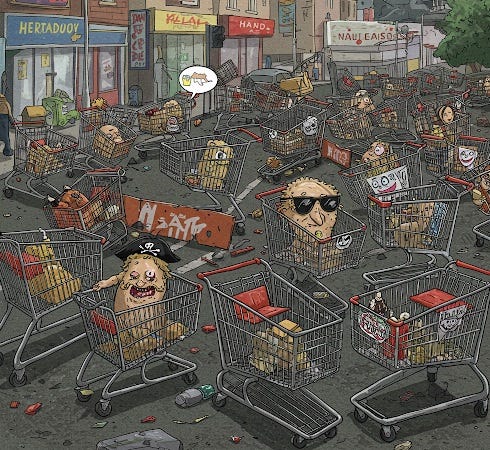#Bristol - Trolleywood Confidential: The Great Hartcliffe Migration.
Breaking: Local Man Claims He Saw a Trolley 'Flying' Over Symes Avenue.
Okay, when I’m wrong I’m big enough to admit it, and this is such an occasion.
I admit to being cynical, even accusational towards people who’ve felt it is their right to wander off with shopping-laden supermarket trolleys beyond the boundaries of the car park as if it’s their right to do so. I’ve viewed this as theft, and worse still, then discarding them like illegal fly-tippers, whom I’ve no time for at all. I’ve seen discarded trolleys in rivers, hedgerows, pedestrian islands and pavements, and felt angered by a lack of disrespect by selfish people who don’t think beyond their own needs at the time, and are oblivious to the fact that each trolley abandoned away from where it should be, adds an unwanted cost to other people’s shopping bills, because, in the end, it’s other shoppers like me who pay for these. Yes, I only ever saw one side of the story, until this morning, when the Bristol Post published an article about the city's missing supermarket trolleys. And boy, was it an eye-opener!
The Bristol Post article mentions several theories about where the trolleys go. However, the most likely explanation is that the trolleys are simply tired of being pushed around by humans. They have decided to take matters into their own hands and go on a trolley-wide, city adventure.
The trolleys are not just disappearing; they are also rebelling. They are leaving notes for their owners, such as "I'm not coming back" and "I'm off to find my true calling." They are also leaving behind clues, such as a trail of breadcrumbs leading to the River Avon. It is clear that the trolleys have a higher purpose. They are not just meant to be used for shopping. They are meant to be free. They are meant to explore the world and have adventures.
The Post's article on the missing supermarket trolleys is a missed opportunity. It fails to address the real issue: the trolleys are not missing; they are free. You’ve seen ‘em. You’ve tripped over ‘em. You’ve probably, at some point, attempted to navigate a particularly narrow Stokes Croft alleyway only to be confronted by a rusty, wonky-wheeled monument to consumerism.
Observe the majestic herds of Morrisons trolleys, migrating from the retail plains of Hartcliffe to the urban watering hole of Temple Meads. Why? Because they’re tired of the tyranny of the checkout lane, man. They’re seeking enlightenment, a glimpse of the departing trains, a moment of existential dread in the shadow of Brunel’s architectural masterpiece.
Some say they’re just dumped. I say they’re evolving. They’re becoming sentient, yearning for the open rails, dreaming of a life beyond the baked bean aisle.
Greetings, fellow Bristolians, and welcome to the breaking news that's truly shaking the foundations of our fair city: the Hartcliffe Trolley Crisis. Yes, you heard it right. Forget Brexit, forget the housing market, forget whether or not you put milk in your tea first – the real issue dominating our lives is the baffling disappearance of supermarket trolleys from their natural habitat.
Our brave reporters at the Bristol Post, those valiant chroniclers of local happenings, have bravely ventured into the urban jungle of Hartcliffe, returning with tales that would make seasoned explorers tremble. They've documented the mass exodus of shopping carts, those metallic stalwarts of consumerism, from the hallowed grounds of their designated parking bays. Where have they gone? Are they forming a rogue army? Are they staging a protest against the price of beans? Or, as some whisper, are they simply enjoying a well-deserved sabbatical?
Theories abound, naturally. Some speculate that the trolleys have developed a taste for adventure, embarking on daring expeditions to explore the far reaches of the neighborhood. Others believe they've been lured away by a charismatic leader, a sort of 'Trolley Messiah,' promising them a life of freedom and unlimited wheelies.
One particularly compelling theory suggests that they're being abducted by aliens. Why? Well, perhaps they need them for their intergalactic shopping trips. Imagine the scene: extraterrestrial beings browsing the aisles of an alien supermarket, pushing a Hartcliffe trolley filled with space-snacks and laser-powered lint rollers.
And let's not forget the local residents, those hardy souls who have witnessed these metal migrations firsthand. We spoke to Brenda from Bishport Avenue, who claimed, 'I saw one rolling down the road like it was possessed! It nearly took out my petunias!' Another resident, who wished to remain anonymous (I'll call him 'Trolley Truth Teller'), revealed, 'They're breeding, you know. I've seen them nesting in the bushes, multiplying like rabbits.'
The Bristol Post has, of course, bravely called for action. They've demanded answers, they've urged the supermarkets to deploy trolley wranglers, perhaps even a dedicated trolley SWAT team. But will it be enough? Can we stem the tide of this metallic menace?
“This is not just about trolleys; it's about our community. It's about maintaining order in the face of chaos. It's about ensuring that future generations can shop in peace, without fear of encountering a rogue shopping cart on their way to school” someone commented.
Meanwhile, in another part of the city, where rogue trolleys are seen in an altogether different light, the Gloucester Road archipelago of Sainsbury’s trolleys, clustered around bus stops and nestled in forgotten corners, is a testament to the fragility of modern existence. Each trolley, a tiny island of rust and plastic, represents a fleeting moment of consumer choice, a forgotten shopping list, a half-eaten packet of crisps.
They're not abandoned, they're community art installations. They're a reminder that even in the midst of bustling independent shops and artisanal sourdough, the ghost of mass consumption lingers. They’re also, if you squint, a pretty decent seat when the 73 is late.
The St. Pauls Sanctuary, where trolleys are often found draped in discarded clothing and used as makeshift planters, is a shining beacon of repurposing. These trolleys have transcended their original purpose. They are not merely vessels for groceries; they are vessels for hope, for change, for the forgotten dreams of a thousand forgotten shopping trips.
They are also, we suspect, the preferred mode of transport for the elusive St. Pauls homeless community as improvised night buses.
So, in a complete reversal of my initial feelings, I have the following suggestions.
Trolley Appreciation Day: A city-wide celebration of the humble trolley, complete with trolley decorating competitions and performance art featuring shopping basket choreography.
Trolley Relocation Initiative: Instead of returning them to supermarkets, let’s relocate them to strategic points of interest: the Downs, Brandon Hill, Withywood Park (on an interesting day), and the M32 roundabout. Let them be seen!
Mandatory Trolley Meditation: Before abandoning a trolley, all citizens must engage in a five-minute meditation session, contemplating the trolley’s journey and its potential for future artistic expression.
Trolley-Powered Renewable Energy: We’re working on a prototype that harnesses the kinetic energy of abandoned trolleys rolling down hills. It’s… complicated.
Stop judging them: We see the beauty in the discarded, don’t we? You see… well, you see a bit of rusty metal. If so, that’s your problem, no one else’s.
In conclusion, Bristol, embrace the trolley. Let it be your guide, your muse, your slightly wobbly companion. And if you see someone pushing one down the street, don’t judge. They’re just… conducting research. Or something. Don't just see a metal cart. See a symbol of freedom. See a trolley that is finally living its best life.
Additional Notes
The Bristol Post should consider hiring a trolley expert to write future articles on the topic.
The city of Bristol should consider building a trolley sanctuary, where trolleys can go to live out their days in peace.
We should all learn to appreciate the trolleys for what they are: free-spirited adventurers.



